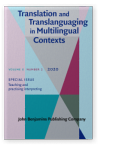Community/Public-service interpreting as a communicative event
A call for shifting teaching and learning foci
Research in Community/Public-Service Interpreting, also referred to as Dialogic Interpreting, has been growing at
a steadily pace in the last two decades. Developments in technology enabling remote access to services, as well as increasing
immigration waves, and people’s mobility are all factors that contribute to the growth of interactions requiring interpreting,
and, consequently, the resulting studies about them. Interestingly, however, the results of empirical research have barely begun
to permeate practice, specifically the teaching and learning of community/public-service interpreting. A look at the professional
development opportunities offered by community agencies, some educational programs, as well as some statements in codes of ethics
or standards of practice of interpreting associations, reveals little dialogue between practice and theory/research. In this paper
I explore this disconnect and suggest areas that could benefit from a deeper dialogue among stakeholders to enhance the education
of current and future interpreters.
Article outline
- 1.Introduction
- 2.Some relevant theories to interpreting
- 2.1Theories on social psychology on interpersonal relations
- 2.2Social theories
- 2.3Theories from linguistic anthropology
- 3.CI/PSI as a communicative event: What can we learn and why does it matter?
- 4.Interpreter’s communicative competence and its relevancy to the teaching and learning of CI/PSI
- 5.Tensions between research and practice: Some possible explanations/examples
- 5.1A narrowly-defined situated practice
- 5.2Transfer of initial efforts in interpreter education from conference interpreting
- 5.3Conceptualizations of professionalism of CI/PSI around the world
- 6.Conclusion
-
References
